Ukraine war latest: Zelensky meets soldiers fighting on Kupiansk-Lyman axis

Key updates on Oct. 3:
- Zelensky meets soldiers fighting on Kupiansk-Lyman axis
- Ukraine to procure 100 high-voltage transformers to prepare for Russian attacks on energy infrastructure
- Ukraine adds Chinese oil, gas companies to 'international sponsors of war' list
- Russian finance minister: Ukraine war is Moscow’s main budget priority
- Bloomberg: U.S. military 'ready to deliver' cluster-armed ATACMS
President Volodymyr Zelensky visited combat brigades on the front line in Kharkiv Oblast fighting on the Kupiansk-Lyman axis, the President's Office said on Oct. 3.
Zelensky spoke to commanders about the operational situation on the battlefield, the progress of offensive and defensive operations, and the current issues faced by units.
“The Kupiansk-Lyman direction is one of the hottest on the front. The Russian invaders are constantly trying to advance there,” the President’s Office said.
Zelensky was briefed on the units' critical needs, with the commanders most often mentioning anti-aircraft and electronic warfare equipment as well as certain types of ammunition.
The president also presented state awards to soldiers and combat medics, thanking them "for every day and night that you give for all of us, without sparing yourself."
"Each of our combat brigades, each soldier who destroys the invaders, asserts with each step forward that Ukrainian victory will certainly come," said Zelensky.
Russia has been concentrating its forces around Kupiansk in Kharkiv Oblast since mid-July, trying to regain positions lost during the Ukrainian surprise counteroffensive last autumn. The city was occupied by Russian forces in 2022 from Feb. 27 to Sept. 10.
The Institute for the Study of War (ISW) wrote on Sept. 28 that Russian troops had reduced the tempo of their localized offensive operations on the Kupiansk-Svatove-Kreminna line.
Ukraine to procure 100 high-voltage transformers to prepare for Russian attacks on energy infrastructure
Ukraine will either manufacture or purchase 100 new high-voltage transformers as the country prepares for a repeat of last winter's Russian attacks on energy infrastructure, according to a report by The Economist on Oct. 2.
Due to previous strikes on Ukrainian factories, many of the transformers will need to be purchased from abroad. In order to protect them from Russian attempts to destroy them in the future, the foreign-made transformers will be stored in Poland or Romania until they are needed.
Energy Minister Herman Halushchenko said that Ukraine has gained considerable experience in dealing with large-scale attacks and their consequences, and engineers have developed innovative plans to protect critical infrastructure and keep power on.
However, he also cautioned that Russia may have learned from last winter's failure to fully knock out the electrical system, and may change their tactics.
Russia began attacks on critical energy infrastructure in Oct. 2022, causing widespread damage and massive disruptions to the power grid. According to The Economist, "the average Ukrainian home was without electricity for an average of five weeks" between October and December.
Russia already has begun to strike at Ukraine's critical structure this year, and Ukraine has put considerable effort into preparing for the inevitable escalation of strikes this coming winter.
Ukraine adds Chinese oil, gas companies to 'international sponsors of war' list
Ukraine's National Agency on Corruption Prevention (NACP) has added the three largest Chinese oil and gas companies to its "international sponsors of war" list, the agency's press service announced on Oct. 3.
China Petrochemical Corporation (Sinopec Group), China National Offshore Oil Corporation (CNOOC Group), and China National Petroleum Corporation (CNPC) reportedly continue to buy crude oil and gas from Russia and invest in Russian energy projects.
NACP said CNPC and a subsidiary of CNOOC have a stake in a liquefied natural gas project in the Gyda Peninsula in Siberia called the Arctic LNG-2.
Russian dictator Vladimir Putin attended the opening ceremony of the project. Once fully implemented, the Arctic LNG-2 could increase Russia's share of the global LNG trade to 15%, nearly double its current share, according to the NACP.
CNPC is also allegedly involved in a number of other Russian energy projects, including the Yamal LNG project, the Power of Siberia gas pipeline, and the Eastern Siberia–Pacific Ocean oil pipeline.
The company agreed with Russian state-owned energy company Gazprom to make payments in their respective national currencies, "which strengthens and stabilizes the Russian ruble" despite international sanctions, the NAPC added.
The NACP added another major Chinese company, Alibaba Group Holding Limited, to its list of international sponsors of war on Aug. 17.
The company owns the online shopping portal AliExpress and was included on the list partly for supporting Russia financially by paying taxes in the country.
Its platforms also allegedly facilitate the sale of copper allegedly exported from the occupied territories of Ukraine.
The 'international sponsor of war' is designed to be "a powerful reputational tool," the NACP explains on its website.
The NACP aims to encourage the exit of international business from Russia, reducing the country's "financial and technological ability to kill Ukrainians."
Multinational companies like Unilever, Bacardi, and PepsiCo are currently included on the list.
Russian finance minister: Ukraine war is Moscow’s main budget priority
The main priority for Russia’s budget for the next three years is strengthening the country’s military and “supporting participants” of its war against Ukraine, Russian Finance Minister Anton Siluanov said on Oct. 3, as cited by Forbes Russia.
Russia plans to spend 10.77 trillion rubles (around $107 billion) on its military in 2024, which is twice as much in 2023 and three times more than in 2021, before the full-scale invasion of Ukraine.
Next year's military spending will become Moscow's largest budget item for the first time, surpassing social policies, Forbes Russia wrote.
"The resources planned for next year make it possible to fully meet the objectives of the special military operation (all-out war against Ukraine)," Siluanov said at a budget hearing before the upper house of Russia's parliament.
The Kremlin also plans to allocate about $661 million for the production of drones to ensure over 40% of Russian drones are manufactured domestically, according to the finance minister.
On Sept. 15, the Ukrainian government approved the draft budget for 2024, under which over half of all funds will be spent on security and defense.
Ukraine's defense expenditures for 2024 amount to around $45.6 billion, which is $3 billion more than this year.
Bloomberg: US military 'ready to deliver' cluster-armed ATACMS
The U.S. military is ready to send Ukraine some of its long-range Army Tactical Missile Systems (ATACMS) armed with cluster munitions, Bloomberg reported on Oct. 3, citing the U.S. military's chief weapons buyer.
Doug Bush, the assistant secretary of the U.S. military for acquisition, logistics, and technology, said that the force has already identified the missiles that will be sent to Ukraine.
The U.S. military "has been postured for this eventuality for a while," Bush told Bloomberg, adding, "we're ready when and if the president decides to do this."
According to the U.S. military's official weapons handbook, cluster-armed ATACMS have a range of up to 300 kilometers (190 miles) and can carry up to 950 cluster munitions, Bloomberg said.
To fire the weapons, Ukrainian forces will need to make minor modifications to launchers already used to fire GPS-guided missiles, Bush added.
Ukrainian President Volodymyr Zelensky has long been campaigning for the delivery of ATACMS, due to their ability to hit targets deep behind the front line.
On Sept. 22, multiple media outlets reported that Biden had agreed to deliver a limited number of the missiles.
The reports came shortly after Zelensky’s four-day visit to the United States, during which he met with Biden and U.S. Defense Secretary Lloyd Austin.
The date or further details of the delivery of ATACMS have not yet been revealed.










